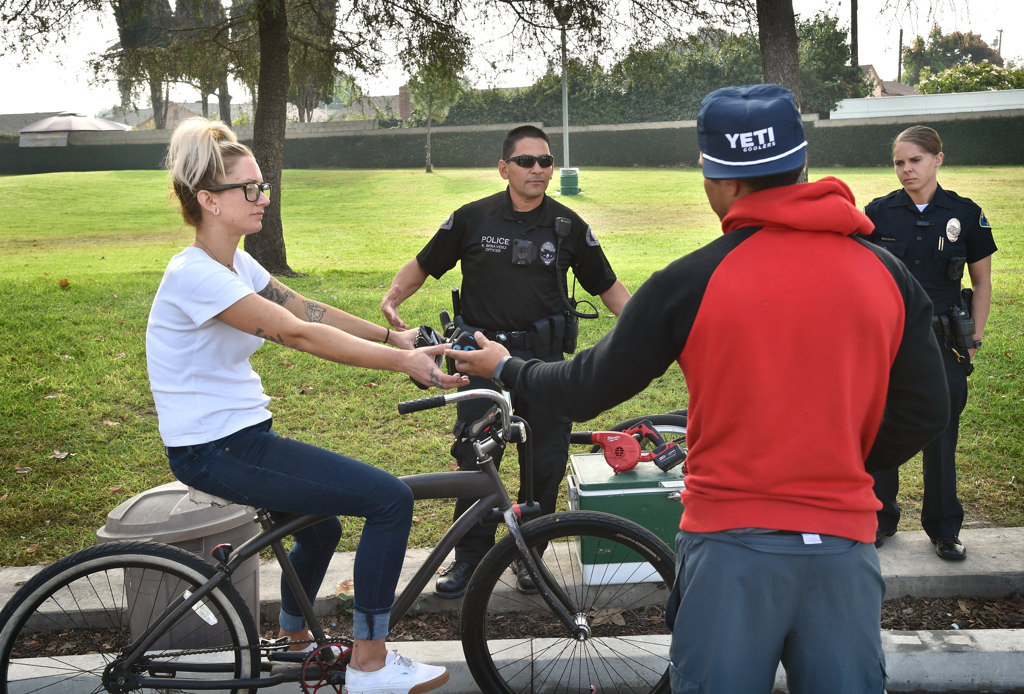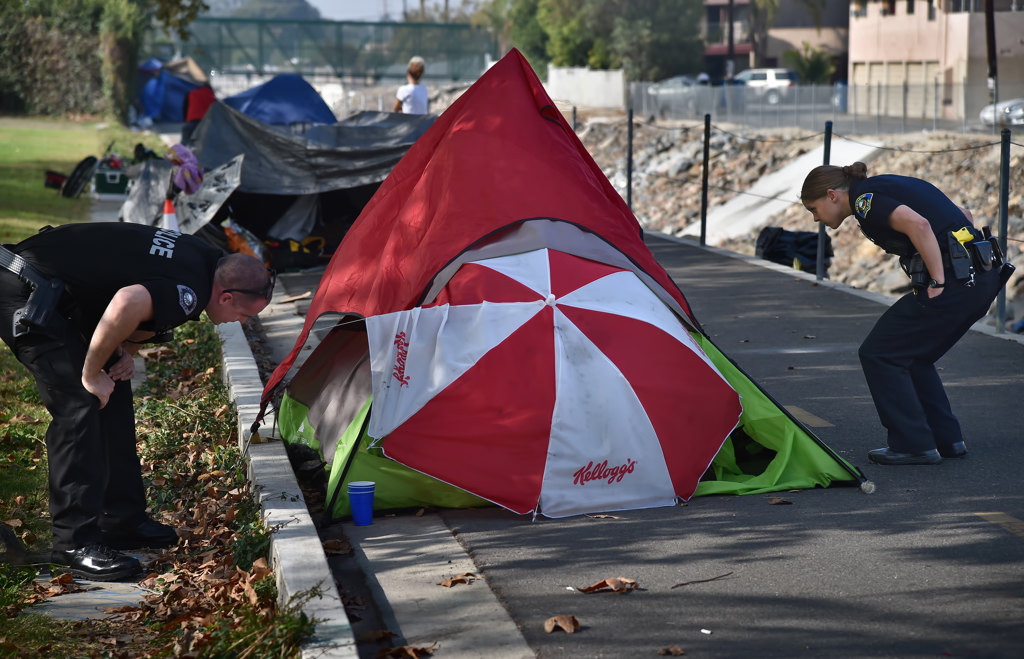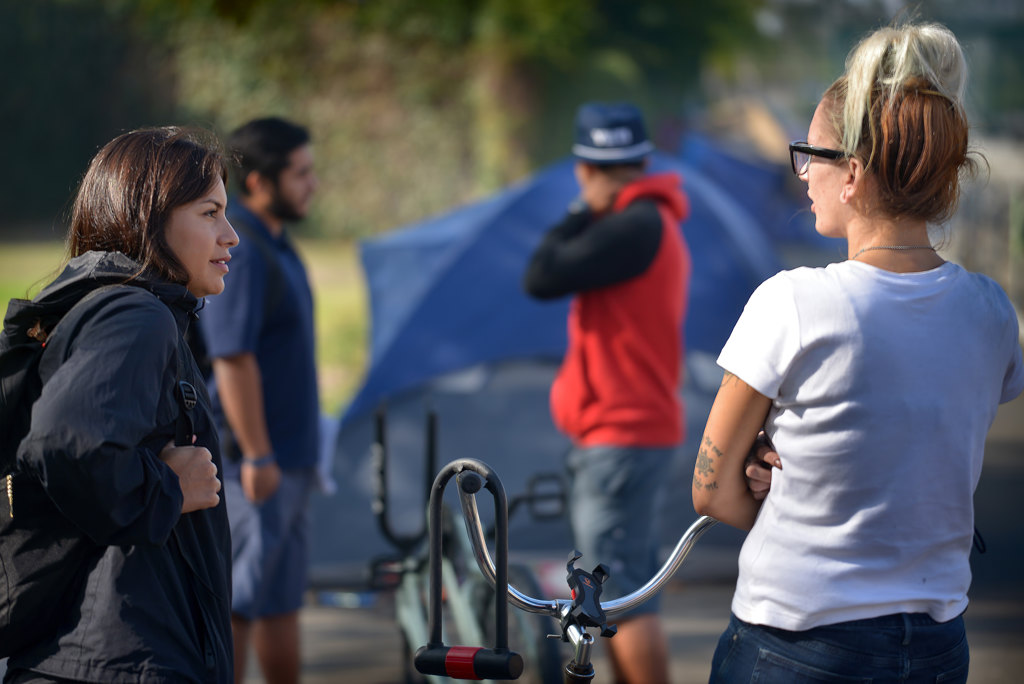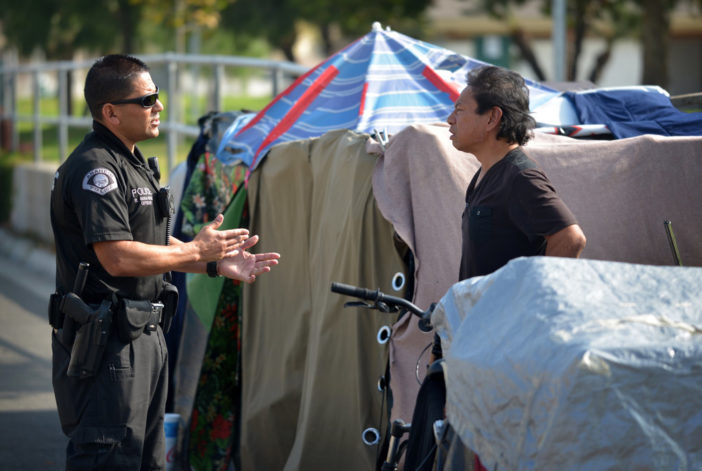Follow us on social media:
As the black Tahoe slowly moved across the grass toward the line of tents on the perimeter of the park, several inhabitants scattered on bicycles and on foot.
A few remained where they were, including a couple in their 20s who were expecting the officers from the Anaheim PD on this recent weekday morning in Schweitzer Park.
The day before, members of the APD’s HOT (Homeless Outreach Team) had talked to the young couple. Both of them said they were ready to move into a shelter. The officers told them to clean up their belongings on the paved bikeway along a river channel near Lincoln Avenue and Beach Boulevard, and be ready for them the next day.
As promised, the officers returned to get the couple off the streets, joined by case managers at City Net, which works to get Anaheim’s homeless into transitional or permanent housing.
HOT Officer Roberto Benavidez approached the woman, who said her first name was Morgan.
“Are we going to get you into a shelter today?” Benavidez asked Morgan, 23, as she sat on a bike. Her boyfriend stood a few feet away talking to Sara Valenzuela, a City Net case manager.
Morgan, who with her boyfriend has been living in the park for a couple of months, hesitated.
“I’m not ready to go today,” Morgan told Benavidez. “We want to take advantage of this, but not this second.”
She explained that her mother was in town and that she wanted to spend time with her.
“Have you thought about drug rehab?” Benavidez asked her.
Morgan said she wasn’t ready.
“Well, we want to get you some help,” Benavidez said.
“I appreciate it,” Morgan said. “It’s nothing personal.”
Taylor, her boyfriend, similarly hesitated.
The bed that had been available to him at Bridges at Kraemer Place, a transitional shelter in Anaheim, soon was taken by another man.
Taylor and Morgan then went about their business, and the officers checked on other people living in the tents.
The Oct. 23 encounter at Schweitzer Park between members of HOT and the homeless couple was typical.
There are plenty of resources out there to get the homeless off the street, the officers say. But getting people to take advantages of the resources usually is another story.

APD Officer Roberto Benavidez and Officer Stephanie Hall talk to people living in Schweitzer Park in Anaheim.
Photo by Steven Georges/Behind the Badge
“Our combination of outreach and enforcement is what convinces some of these folks to eventually accept the resources that are available, but it takes multiple contacts,” said Sgt. Mike Lozeau, who helped found HOT in 2013 and still runs it, along with the APD’s related PERT, for Psychiatric Emergency Response Team.
Now a model throughout the state and beyond, Anaheim’s HOT – despite the challenges – has enjoyed great success.
The unit, which has grown to five full-time officers and a sergeant from two officers and a sergeant in 2013, has helped get more than 1,400 people out of homelessness, thanks to the team’s collaboration with City Net. And only about 10 percent of those 1,400 have ended back on the streets, Lozeau said.
“My direction to the team has always been outreach first, followed by fair and consistent enforcement to either drive (the homeless) toward compliance or drive them toward outreach,” Lt. Craig Friesen said of HOT, which operates out of the APD’s West Station on Beach Boulevard.
In addition to Lozeau and Benavidez, HOT members include Officers Eric Meier, Zach Peterson, Danny Lambaren and Curtis Bynum. HOT sometimes is supported by three officers and a sergeant on the APD’s West Community Policing Team.
In addition to City Net case managers, the team, which works from 6 a.m. to 4 p.m., usually is accompanied by Colin Wormer of Drug Free Anaheim, which connects those willing to get help with treatment providers.
Twice a week, HOT goes out with City Net case managers to do outreach at night. That soon will expand to five nights a week.
INFLUX INTO PARKS
After the Santa Ana riverbed homeless encampments that spanned from Ball Road in Anaheim to the I-5 in Orange were cleared out earlier this year, HOT had its hands full not only at Schweitzer Park, but also at nearby Maxwell Park, on West Broadway between Dale and Magnolia Avenues.
Friesen and Lozeau said the number of homeless that regularly congregate in both parks has exploded.
The average homeless population in Maxwell Park, which is surrounded by homes and is next to Maxwell Elementary School, ranges from a couple dozen to 50, said Friesen, who provided some other telling statistics.
From June 1 through Oct. 9, HOT made 110 arrests for narcotics, possession of stolen cars, outstanding warrants and the like in Maxwell Park alone, the lieutenant said. In addition, at Maxwell Park, APD officers have written 34 tickets for municipal code violations (such as drinking in public) and 71 field interrogation reports.

Anaheim PD Homeless Outreach Team (HOT) members, from left, Officer Eric Meier, Sgt. Mike Lozeau, Officer Curtis Bynum, Officer Daniel Lambaren, Officer Roberto Benavidez and Officer Zachary Peterson.
Photo by Steven Georges/Behind the Badge
In comparison, during the same period in La Palma Park, another frequent gathering place for the homeless, the APD wrote six tickets for municipal code violations and 14 field interrogation reports.
“So, we’re seeing almost triple the amount of arrests in Maxwell Park,” Friesen said.
Steps have been taken to discourage the homeless from camping in Maxwell Park. For example, the Haskett Branch Library in the park has confined its Internet signal to work only inside the library after HOT officers recommended the change. HOT members also told nearby residents with unsecured wifi signals to secure their connections with passwords.
Last year in Anaheim alone, there were about 16,000 calls for service regarding the homeless, Lozeau said.
“I think we’re going to be close to 20,000 calls this year,” he said.
In contrast, in 2007, the City of Anaheim had about 3,000 calls for service regarding the homeless, Lozeau said.
Lozeau and Friesen blame the dramatic spike, in part, on the economic downturn in 2008, changes in state sentencing laws, and a shortage of beds in homeless shelters. A state mental health system also in desperate need of fixing is part of the problem, they said.
But the APD, they said, remains committed to remaining a leading law enforcement agency when it comes to homelessness. Lozeau, for example, currently is the only POST-certified instructor in the state who teaches other law enforcement agencies about strategies to help the homeless.
“Anaheim’s a model, and the word is starting to get around,” Lozeau said.
In Schweitzer Park, Officers Benavidez and Peterson were joined by new APD Officer Stephanie Hall in conducting outreach with the homeless. For about a year now, all new APD officers have been spending a week with HOT and PERT officers as part of their regular training.
In Schweitzer Park, Peterson spent several minutes with a 51-year-old man living in a tent who said he was sober and going through a divorce.
The man told Peterson he has a daughter, 27, and a grandchild in Los Angeles, but that it’s a burden for him to stay with them.
Peterson noticed a nasty wound on the man’s leg. The man said he got it from a spider bite, and claimed he had been to the hospital a day earlier.

APD Officer Zachary Peterson and Officer Stephanie Hall try to get a homeless man to come out and talk to them about taking advantage of services for the homeless.
Photo by Steven Georges/Behind the Badge
Judging by the look of the wound and the dirty gauze that partially covered it, Peterson was skeptical.
“You’re definitely not getting any help out here,” he told the man. “If you want help, it’s available for free.”
Added Peterson: “This is not a good situation, my friend.”
The man promised to reach out to his daughter over the coming weekend.
Back inside the Tahoe heading to Maxwell Park, Peterson said drugs and alcohol are a huge problem with the homeless.
“I’d say 99 percent of the people I’ve talked to have some sort of substance abuse problem,” Peterson said. “If they want help, it’s not too hard to get.”
In Maxwell Park, a tattooed man who said he’s an alcoholic was making scrambled eggs for his handful of friends.
“Anyone interested in going to a shelter today?” Benavidez asked the group.
The man making breakfast said he came to Maxwell Park from the Santa Ana River Bed two years ago, and doesn’t like shelters.
“There are just too many rules,” said the man, who told Benavidez he became homeless after he lost his job at a mortuary.
Ralph, his friend, was coming down from a heroin high. He’s kicked his meth habit, but not heroin.
Peterson urged Ralph to go into treatment.
Ralph, 55, told Peterson he’s afraid of feeling sick during withdrawals.
In a nearby tent, a woman, Lisa, was applying makeup to her face. She told the HOT officers she recently was in a shelter, but left.
“It smelled too bad in there,” Lisa said.
Anaheim, which is part of the North Service Provider Area, is working on opening more shelter beds. By early 2019, the city plans to open 325 temporary beds in two shelters ahead of a permanent 400-bed Salvation Army shelter scheduled to open by late 2020.
Friesen said he’s proud of the work his HOT officers are doing, despite the challenges.

Jos Guevara, collaborative case manager for City Net Homeless Outreach, left, tries to match homeless people staying at Schweitzer Park with services that can get them off the street.
Photo by Steven Georges/Behind the Badge
“Our officers do some outstanding work in difficult and sometimes unsanitary conditions,” he said. “They’re tasked with finding the balance between outreach and enforcement on a daily basis. That’s why we partner with so many non-profit organizations. They help us with the heavy lifting of connecting people to the wide variety of services available to the homeless population. Our goal is to help those that are service resistant to realize there is help available, while also conducting enforcement to provide our citizens with a safe community.”
HOT members left Maxwell Park and pulled up to a dry cleaner after they noticed a marked increase in the number of homeless people and their belongings over the last 24 hours.
A man they recognized was sitting in a wheelchair. He had a wound on his right leg caused by MRSA, for methicillin-resistant staphylococcus aureus, a bacterium that causes infections.
They summoned a crew from Anaheim Fire & Rescue to take the man to the hospital.
The captain and his crew know him by name.
“He’s a frequent flier,” the captain said, referring to the man’s frequent trips by ambulance to the ER.
Outside the dry cleaner, Benavidez talked to a woman.
“You ready to go to a shelter?” he asked her.
“Yes,” said the woman, Rochelle.
Benavidez and his partners on HOT have enjoyed many successes over the years. He recalled a woman with six kids who had been living in a park. She now is living in a home in Victorville after she received some initial rent assistance.
“I think we’re making a difference,” Benavidez said. “Even the rapport that we’re having with these people is making a difference, because they get it. They appreciate what we’re doing.”
Rochelle asked Benavidez if her husband could come to the shelter with her.
Sure, if there’s a bed available, the officer told her. But he’ll have to stay in the men’s-only section, of course.
Rochelle said she needed to consult with her husband, who was nearby but out of sight.
“I’ll be right back, I promise you,” Rochelle told Benavidez.
Thirty minutes passed, and there was no sign of Rochelle.
The members of HOT hopped back into their black Tahoe and moved on.

APD Officer Roberto Benavidez checks in on a person living in a tent at Schweitzer Park in Anaheim.
Photo by Steven Georges/Behind the Badge
Follow us on social media:
 Behind the Badge
Behind the Badge




